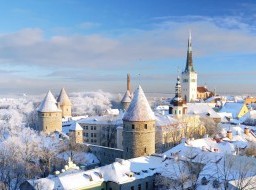Tallinn
Located on the coast of Gulf of Finland, Tallinn is a well known city and capital of Estonia. Tallinn is an intoxicating mix of ancient church spires, glass skyscrapers, baroque palaces, appealing eateries, brooding battlements, shiny shopping malls, run-down wooden houses, and cafes set on sunny squares – with a few Soviet throwbacks in the mix, for added spice. Many relics of Tallinn’s long history survive or have been restored, especially on Toompea hill and in the old, walled Lower Town. They include the 13th-century Toom Church, the Gothic Oleviste and Niguliste churches, the Great Guildhall of 1410, the 14th-century Rathus, and much of the old castle. The city’s historic centre was designated a UNESCO World Heritage site in 1997. Despite the boom of 21st-century development, Tallinn remains loyal to the fairy-tale charms of its two-tiered Old Town – one of Europe’s most beguiling walled cities. Port of Tallinn is the biggest port authority in Estonia. If you are a lover of history and enjoy shopping on the streets, this is one city that you just can't avoid to miss. Tallinn is an exceptionally complete and well-preserved medieval northern European trading city on the coast of the Baltic Sea. The combination of the upper town on the high limestone hill and the lower town at its foot with many church spires forms an expressive skyline that is visible from a great distance both from land and sea. The upper town (Toompea) with the castle and the cathedral has always been the administrative centre of the country, whereas the lower town preserves to a remarkable extent the medieval urban fabric of narrow winding streets, many of which retain their medieval names, and fine public and burgher buildings, including town wall, Town Hall, pharmacy, churches, monasteries, merchants’ and craftsmen’ guilds, and the domestic architecture of the merchants' houses, which have survived to a remarkable degree. The distribution of building plots survives virtually intact from the 13th-14th centuries. The first reliable account of Tallinn's history comes from The Chronicle of Latvian Henrik, wherein Henrik describes the landing of the Danish fleet, led by King Valdemar II, in June of 1219. The Danes quickly snapped up Tallinn as their own and built a large fortress on Toompea Hill. The name 'Tallinn' is actually derived from the Estonian words 'taani linnus,' meaning 'Danish castle.' Temporarily gaining power from the Danes, the enigmatic Order of the Brotherhood of the Swords governed Tallinn from 1227 to 1238. Around 1230, German merchants from Gotland were invited to Tallinn by the Brotherhood, and their arrival is today considered an important addition to Tallinn's population, which was predominantly German for centuries. In 1248, Tallinn became a member of the Hanseatic League, a mercantile and military alliance of German-dominated cities in Northern Europe. Medieval Tallinn was one of the best-fortified cities in Europe. The town wall was contructed in the 14th century with 66 defense towers adorning it (today only 20 remain). The major boom in town construction (resulting in most of the fine medieval facades that visitors will still see there today) hit Tallinn in the 15th century; however most of the significant places of worship were built in the 13th century, including Niguliste Church (1230), Oleviste Church (first mentioned in 1267) and St. Catherine's convent (begun in the 1240s). Tallinn benefited from its strategic position as a major crossroads for trade between Western and Northern Europe and Russia. At this time most merchants and profitmakers were Germans, though at least half of its population of 8000 were native Estonians. By the end of the Middle Ages, residency for native Estonians had become very difficult due largely to a high residency fee and many Estonians were forced out of the centre. This German influence over the city became even stronger with the beginning of the Protestant Reformation in the mid-1500s. Estonia soon became a major battleground as Russia, Sweden, Poland and Denmark all duked it out for superiority in the Baltic Sea during the Linovian War (1558 - 1583). Tallinn surrendered to the Swedish crown in 1561, and remained under Swedish rule for the next 150 years, despite two Russian seiges. During the Great Northern War, the Swedes indulged Imperial Russia, wrapping Tallinn with a bow and presenting it to the tsar in 1710; Tallinn's German rulers, however, remained culturally and economically autonomous. The 19th century brought industrialization to Tallinn and the port continued to play an important role, but the pressures of Russification were mounting by the end of the century. On February 24, 1918, the Independence Manifesto was proclaimed in Tallinn, with the unforeseen side effects of immediate German occupation and a war with Russia. On February 2, 1920, a peace treaty with Russia was signed. Tallinn became the capital of independent Estonia. However, with the outbreak of World War Two, a coup overseen by the Red Army led to Estonia being annexed by the USSR before the invasion by Nazi Germany in 1941. Tallinn's medieval Old Town largely retained its charm. After the retreat of the Nazis in 1944, the Soviets moved in to reoccupy Estonia for the next 47 years. Tallin was then capital of the Estonian SSR. An independent democratic Estonian state was re-established in August 20, 1991. In 1997, UNESCO crowned the Old Town a World Heritage Site, and in 2004 Estonia joined the EU with its Baltic neighbors. Today Tallinn is the face that Estonia turns toward a surging tourist industry enamored with the narrow, steep cobbled streets of the Old Town and its flair for design and the arts. Old Town Days, a festival celebrating Tallinn's medieval past, takes place in summer and for four days in mid-summer the town hall square is turned into a large medieval market where ancient traditions are brought back to life by musicians, artisans and madcaps alike. Few cities have been so successful in preserving the integrity of their past. |






